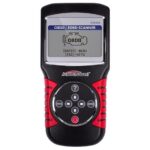The terms “OBDII converter” and “catalytic converter” are often used in the automotive world, sometimes leading to confusion. While related, they serve distinct purposes within a vehicle’s emissions control system. This article clarifies the differences between an OBDII converter and a catalytic converter, focusing on their functions and importance.
Decoding the OBDII System
OBDII, or On-Board Diagnostics II, is a standardized system that monitors a vehicle’s emissions and performance. It uses sensors throughout the engine and exhaust system to detect malfunctions. When an issue arises, the OBDII system stores a diagnostic trouble code (DTC) in the vehicle’s computer, which can be retrieved using an OBDII scanner. This system plays a crucial role in ensuring vehicles meet emissions standards and helps mechanics diagnose problems efficiently. However, an “OBDII converter” as a standalone device doesn’t exist. The term likely refers to devices that interact with the OBDII system, such as:
- OBDII Scanners: These tools allow users to read and clear DTCs, providing valuable information about the vehicle’s health. Some advanced scanners can even display real-time data from various sensors.
- Catalytic Converter Simulators: In some instances, mechanics or vehicle owners might use simulators to temporarily bypass a faulty catalytic converter for testing purposes. These devices typically manipulate the signals sent to the OBDII system, potentially masking underlying issues.
The Role of the Catalytic Converter
A catalytic converter is a critical component of a vehicle’s exhaust system designed to reduce harmful emissions. Located in the exhaust pipe, it contains precious metals (like platinum, palladium, and rhodium) that act as catalysts. These catalysts convert toxic gases like carbon monoxide, nitrogen oxides, and unburnt hydrocarbons into less harmful substances like carbon dioxide, water vapor, and nitrogen. A properly functioning catalytic converter is essential for meeting environmental regulations and maintaining clean air. Catalytic converters are specifically designed for different vehicle types and engine configurations to ensure optimal performance. Regulations, like those implemented in California in 2009 for OBDII vehicles, dictate specific requirements for aftermarket catalytic converters to ensure they meet emissions standards.
Clarifying the Confusion: No “OBDII Converter” Exists
The key takeaway is that there isn’t a physical device called an “OBDII converter.” The term likely arises from the relationship between the OBDII system and the catalytic converter. The OBDII system monitors the efficiency of the catalytic converter using oxygen sensors placed before and after it. If the converter isn’t functioning correctly, the OBDII system will detect the issue and trigger a DTC, illuminating the check engine light.
Conclusion: Two Parts of One System
While there’s no actual “OBDII converter,” understanding the interplay between the OBDII system and the catalytic converter is crucial for maintaining a vehicle’s emissions control system. The OBDII system monitors the performance of the catalytic converter, ensuring it functions efficiently to reduce harmful pollutants. If you encounter the term “OBDII converter,” remember it likely refers to tools interacting with the OBDII system rather than a separate component. Regular vehicle maintenance and using a quality OBDII scanner can help identify potential issues with the catalytic converter and other emissions-related components, ensuring your vehicle runs cleanly and efficiently.

